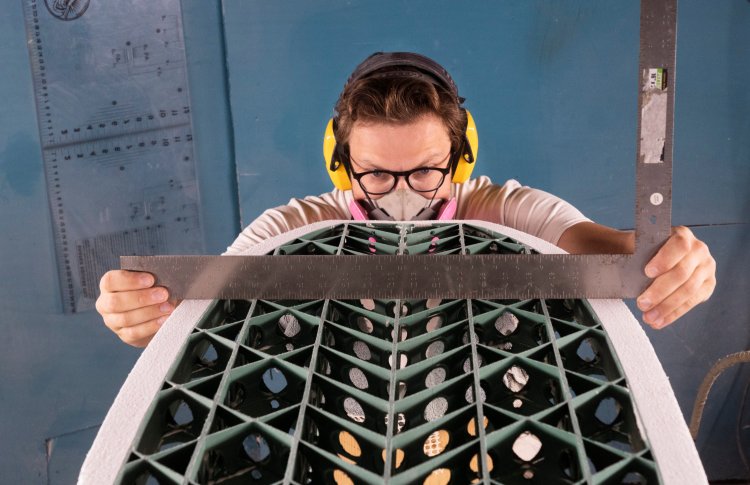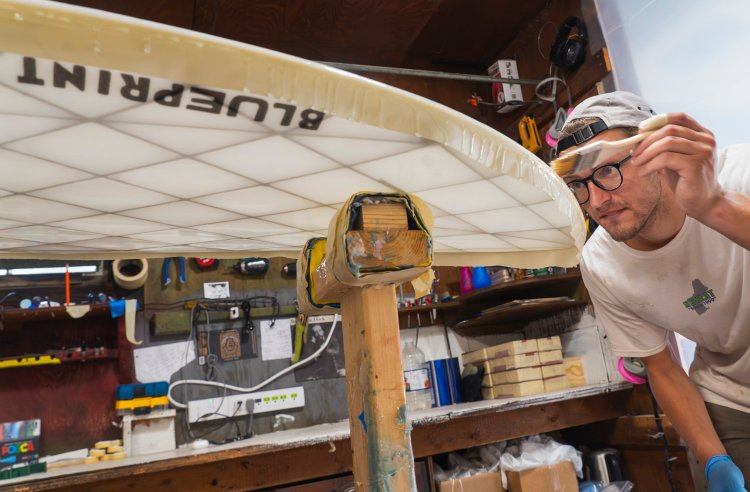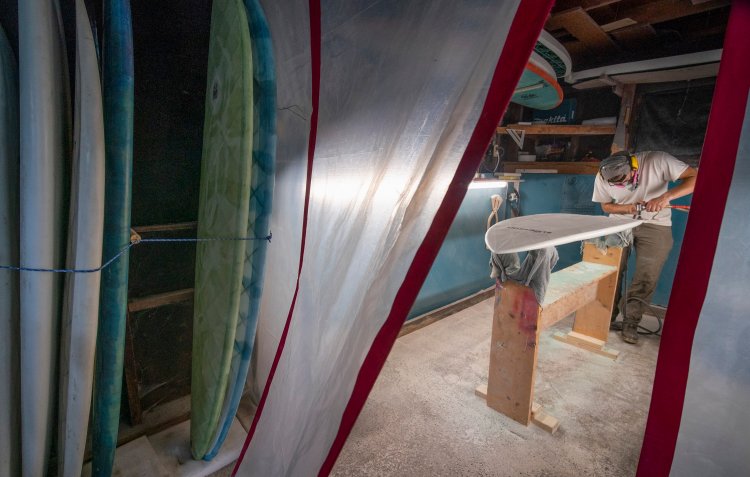Mike Ballin of Blueprint Surf sands one of the company’s 3D-printed surfboard frames before covering it in fiberglass in a South Portland workshop last week. Carl D. Walsh/Staff Photographer
SOUTH PORTLAND — In a small garage where the floors are encrusted with colorful epoxy drippings, sheets of plastic separate rooms and stacks of surfboards line the ceiling rafters, Mike Ballin can be found putting the finishing touches on his newest board.
If he’s not there, he’s gone surfing.
Ballin, 25, and business partner Luke Diehl, 34, are on a quest to turn old fishing nets into surfboards that last longer and are better for the environment than traditional ones.
They founded the startup, Blueprint Surf Co., with three targets in mind for their boards: a minimal carbon footprint, high durability and a strong structure that will help surfers cruise the waves for years to come.
“A really sustainable surfboard needs to last longer than a typical surfboard. So when I go out and surf all of our boards, I just try to break them as soon as I can,” Ballin said. “It’s really good for knowing that if we sell a surfboard, we’re very confident that it’s going to be something that’s going to last a long time.”
Most surfboards are made of fiberglass-coated foam that can dent and wear out. And materials like certain types of resin, which are used to coat boards and make them waterproof, include volatile organic compounds that vaporize and can harm the environment and the people making the boards.
At Blueprint, the surfboards are 3D-printed using plastic from recycled fishing nets, covered in a fiberglass cloth and coated in a bio-based epoxy made from the byproducts of plants like corn and soybeans. The epoxy is odorless and has fewer volatile organic compounds than traditional resins, Ballin said.

Mike Ballin of Blueprint Surf works on the company’s 3D printed surfboards in its South Portland workshop last week. Carl D. Walsh/Staff Photographer
He and Diehl said that each board they make keeps approximately 2 kilograms of plastic out of landfills – the equivalent of 50 plastic bottles. Using sustainable and recycled materials as well as trying to source materials within the U.S. means a lower carbon footprint overall.
“That’s what made it go from, ‘Hey, it would be cool to learn how to make a surfboard, and let’s do it with 3D printing,’ to ‘Wow, this is something that people might really appreciate if we can figure out how to make really good boards and also figure out how to decrease the environmental impact of this industry,’ ” Diehl said.
The manufacturing technique is becoming increasingly popular in Maine. The University of Maine, which has two of the largest 3D printers in the world, is using the technology to print large-scale projects like boats and homes, and is training students to incorporate bio-based and recycled materials like wood waste.
Habib Dagher, director of the UMaine’s Advanced Structures and Composites Center, which houses the printers, said 3D printing is useful because it has a wide array of applications – from making spare parts and tools, to bridges and wind turbines – and can be used with a variety of materials such as wood and concrete. Printed products can be reused as materials for future products, and the technology also can reduce the impacts of labor shortages in Maine by using fewer workers to yield similar results, he said.
“3D printing is not the solution to everything. It’s a tool in a tool shed that could be used to do certain things,” Dagher said. “It’s got to be complex shapes, unique shapes, that’s when it starts to shine.”
Diehl, who lives in Boston, was initially inspired to 3D print surfboards when he was CEO of NanoHive Medical, a company that 3D-prints implants for spinal surgery. The implants are designed with a lattice structure to control their level of stiffness. Having a background in aerospace, aeronautical and astronautical engineering, where he saw a similar lattice skeleton be used in airplane construction, Diehl realized the technique also could be applied to making surfboards.
Diehl met Ballin’s dad while surfing in Gloucester, Massachusetts, and heard about Ballin’s interests in environmental studies, surfing and sustainability at Colby College. Now, Diehl is the CEO of Longshot Ventures LLC, a startup incubator that is supporting Blueprint as it gets off the ground.
Diehl and Ballin print the internal lattice structure using a 3D-printer they own and store at the Roux Institute. The structure can be adapted based on the surfer and the type of waves they’re surfing, and the weight, density and size also can be adjusted.

Mike Ballin of Blueprint Surf seals one the company’s 3D printed surfboards in its South Portland workshop last week. Carl D. Walsh/Staff Photographer
Much of the design process for Blueprint has been trial and error, but Ballin was also able to learn from local shaper Nick Aleandro, founder of Neto Shapes, for six months to gain a greater understanding of the ins and out of the craft.
Aleandro taught Ballin how to reuse excess materials and reduce waste, habits that Ballin now incorporates into Blueprint. Excess materials like the supports used to hold up the board structure during printing get saved and reprocessed into printable plastic for future boards.
“I got really, really lucky to be able to learn from somebody who’s really, really good and has been doing it for many, many years,” Ballin said. “Now I’m at the place where … Luke will come up and be like ‘Wow, these boards look good,’ and I’m like, ‘No, no, no, no, (I) got to fix this, this and this part.’ … It’s a lifelong pursuit to get them perfect but hopefully someday.”
Diehl often handles more of the business side of things while Ballin works on making the surfboards locally. Ballin outfitted a rented garage to be a properly ventilated workshop where he can put the finishing touches on the surfboards by applying a “top secret” composite layer, glassing and sanding them.
Ballin, who now lives in Portland, said his love of surfing began when he was growing up in Gloucester. He became so obsessed that he would surf in the mornings with his friends before high school and sometimes show up to class in his wetsuit. Later, when he was a student at Colby, he led the surf club and would try to get on the water as much as possible.

Mike Ballin of Blueprint Surf works on the company’s 3D printed surfboards in its South Portland workshop. Carl D. Walsh/Staff Photographer
Diehl started surfing when a friend’s dad found some surfboards that had been thrown out, leading him and his friends to get out on the water and give the boards a new life.
“(Surfing) definitely forces me to sort of adapt and relinquish control a little bit and relax and slow down and kind of roll with whatever the ocean gives me,” Diehl said. “With startups, I think it’s the same thing. It’s like you’re always getting new challenges thrown at you, and you’re always being forced to adapt and rethink things that you thought you knew.”
Blueprint Surf offers demo days where surfers can test out the boards.
While surfers can order custom boards from Blueprint’s website, Ballin and Diehl are also hoping to start selling boards at the Maine Surfer’s Union in Portland and Black Point Surf Shop in Scarborough. Ballin and Diehl are still striving to perfect their boards, but they are selling current models for around $700. Traditional boards can cost over $1,000.
Their goal for Blueprint is to have bases all over the country where surfers can have customizable boards printed locally, rather than shipping boards and increasing their carbon footprint.
“We want to be a good, stable contributor to our local surf community and any surf community that we’re in,” Diehl said.
« Previous
Next »
Related Stories
